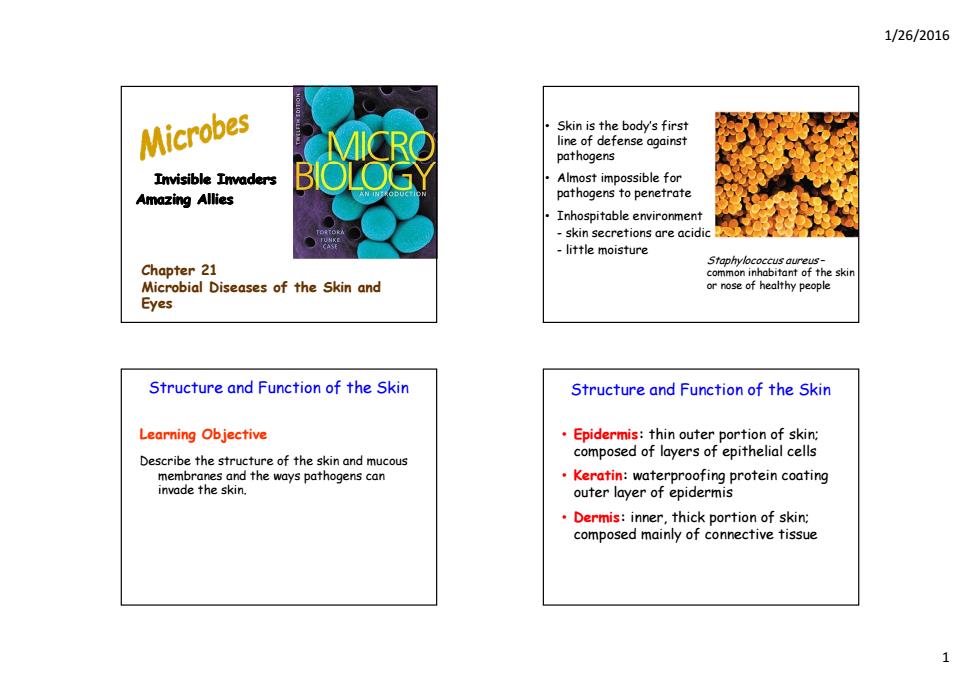
1/26/2016 Microbes Skin is the body's first line of defense against pathogens Invisible Invaders Almost impossible for Amazing Allies pathogens to penetrate Inhospitable environment skin secretions are acidic little moisture Chapter 21 commor Microbial Diseases of the Skin and or nose of healthy people Eyes Structure and Function of the Skin Structure and Function of the Skin Learning Objective Epidermis:thin outer portion of skin; Describe the structure of the skin and mucous composed of layers of epithelial cells membranes and the ways pathogens can Keratin:waterproofing protein coating invade the skin. outer layer of epidermis Dermis:inner,thick portion of skin; composed mainly of connective tissue
1/26/2016 1 Invisible Invaders Amazing Allies Chapter 21 Microbial Diseases of the Skin and Eyes • Skin is the body’s first line of defense against pathogens • Almost impossible for pathogens to penetrate • Inhospitable environment - skin secretions are acidic Staphylococcus aureus – common inhabitant of the skin or nose of healthy people - little moisture Structure and Function of the Skin Learning Objective Describe the structure of the skin and mucous membranes and the ways pathogens can invade the skin. Structure and Function of the Skin • Epidermis: thin outer portion of skin; composed f l f ith li l ll d of layers of epithelial cells • Keratin: waterproofing protein coating outer layer of epidermis • Dermis: inner, thick portion of skin; composed mainly of connective tissue
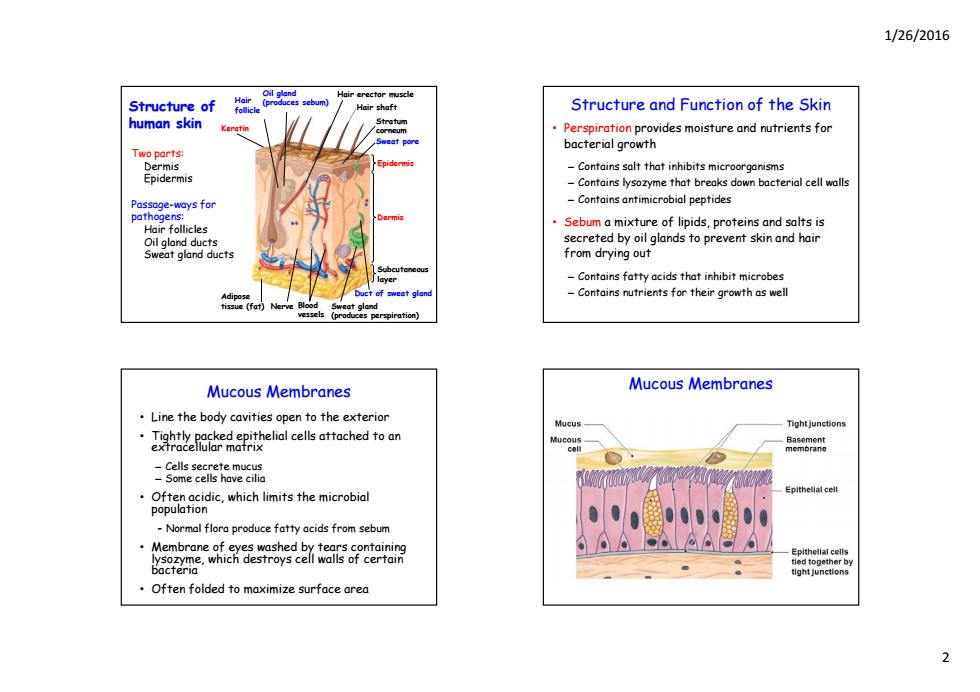
1/26/2016 erector musc Structure of Hair shaft Structure and Function of the Skin human skin Perspiration provides moisture and nutrients for bacterial growth Two parts: Dermis -Contains salt that inhibits microorganisms Epidermis -Contains lysozyme that breaks down bacterial cell walls Passage-ways for -Contains antimicrobial peptides ens: Sebum a mixture of lipids,proteins and salts is nd ducts secreted by oil glands to prevent skin and hair from drying out -Contains fatty acids that inhibit microbes -Contains nutrients for their growth as well aticn) Mucous Membranes Mucous Membranes Line the body cavities open to the exterior Mucus Tightjunctions ‘mam妆icells -Cells secrete mucus Some cells have cilia Often acidic,which limits the microbial Epithelial cell population Normal flora produce fatty acids from sebum Membrane of tied together by Often folded to maximize surface area
1/26/2016 2 Hair follicle Oil gland (produces sebum) Hair erector muscle Hair shaft Stratum corneum Sweat pore Epidermis Structure of human skin Two parts: Dermis Keratin Epidermis Dermis Epidermis Passage-ways for pathogens: Hair follicles Oil gland ducts Subcutaneous layer Duct of sweat gland Sweat gland (produces perspiration) Blood vessels Nerve Adipose tissue (fat) Oil gland ducts Sweat gland ducts Structure and Function of the Skin • Perspiration provides moisture and nutrients for bacterial growth – Contains salt that inhibits microorganisms – Contains lysozyme that breaks down bacterial cell walls – Contains antimicrobial peptides • Sebum a mixture of lipids, proteins and salts is secreted byg p oil glands to prevent skin and hair from drying out – Contains fatty acids that inhibit microbes – Contains nutrients for their growth as well Mucous Membranes • Line the body cavities open to the exterior • Tightly packed epithelial cells attached to an extracellular matrix – Cells secrete mucus – Some cells have cilia • Often acidic, which limits the microbial population - N rm l fl r pr duce f tt cids fr m sebum Normal flora produce fatty acids from sebum • Membrane of eyes washed by tears containing lysozyme, which destroys cell walls of certain bacteria • Often folded to maximize surface area Mucous Membranes
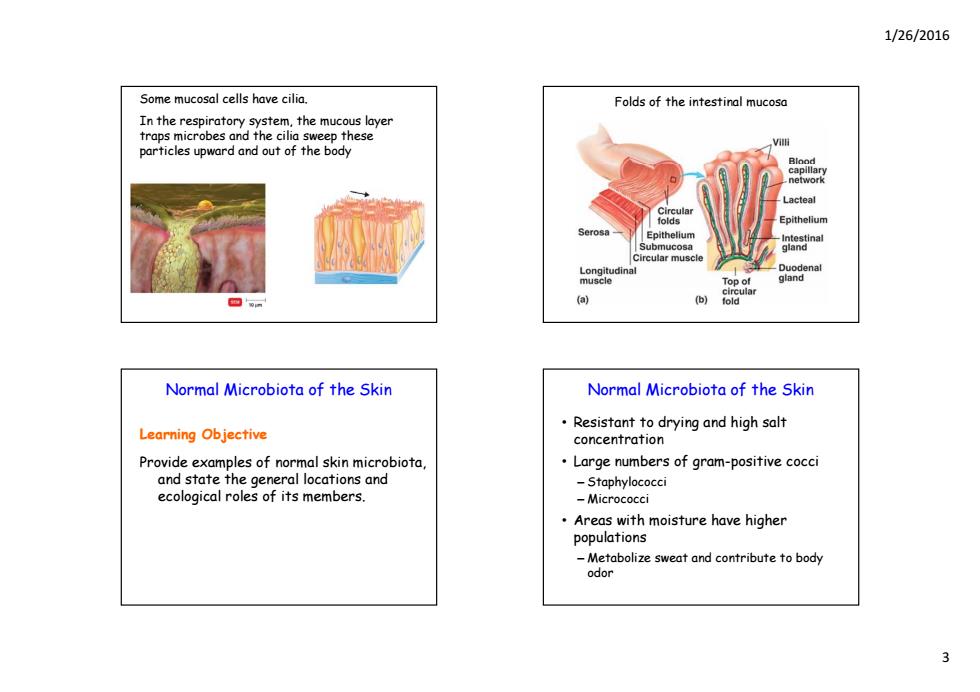
1/26/2016 Some mucosal cells have cilia. Folds of the intestinal mucosa In the respiratory system,the mucous layer traps microbes and the cilia sweep these particles upward and out of the body Blood etwork folds Submucosa Circular muscle Duodenal Top of ular old Normal Microbiota of the Skin Normal Microbiota of the Skin Resistant to drying and high salt Learning Objective concentration Provide examples of normal skin microbiota Large numbers of gram-positive cocci and state the general locations and -Staphylococci ecological roles of its members. -Micrococci Areas with moisture have higher populations -Metabolize sweat and contribute to body odor
1/26/2016 3 Some mucosal cells have cilia. In the respiratory system, the mucous layer traps microbes and the cilia sweep these particles upward and out of the body Folds of the intestinal mucosa Normal Microbiota of the Skin Learning Objective Provide examples of normal skin microbiota, and state the general locations and ecological roles of its members. Normal Microbiota of the Skin • Resistant to drying and high salt concentration • Large numbers of gram-positive cocci – Staphylococci – Micrococci • Areas with moisture have higher populations – Metabolize sweat and contribute to body odor
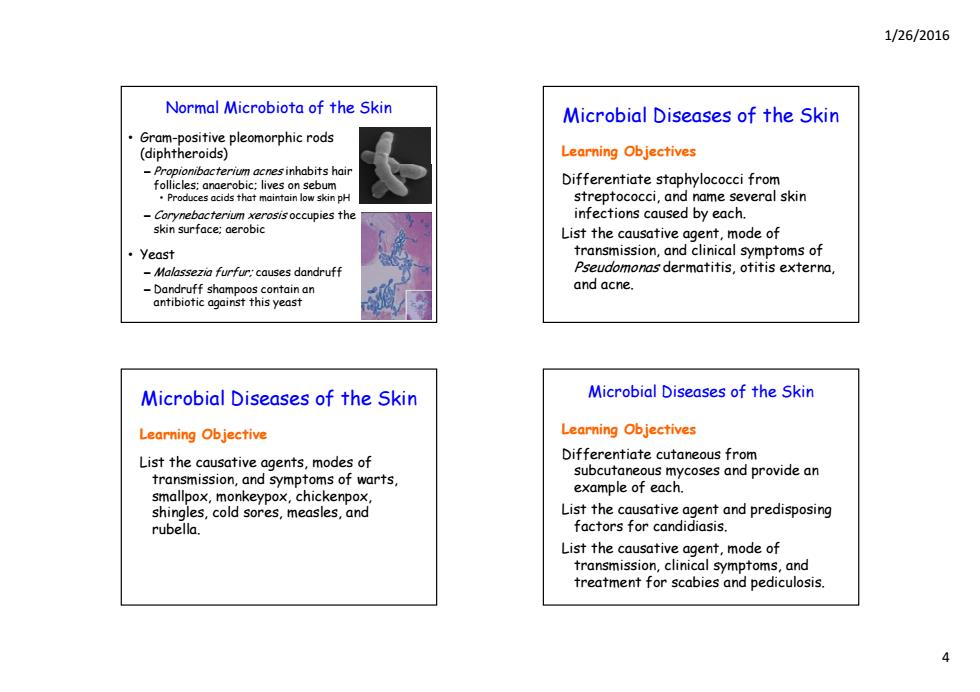
1/26/2016 Normal Microbiota of the Skin Microbial Diseases of the Skin Gram-positive pleomorphic rods (diphtheroids) Learning Objectives -Propionibacterium acnes inhabits hai follicles:anaerobic:lives on sebum Differentiate staphylococci from Produces acids that maintain low skin pH streptococci,and name several skin Corynebacterium xerosis occupies the infections caused by each. skin surface:aerobic List the causative agent,mode of yeast transmission,and clinical symptoms of -Malassezia furfur:causes dandruff Pseudomonas dermatitis,otitis externa, -Dandruff shampoos contain an and acne. this yeast Microbial Diseases of the Skin Microbial Diseases of the Skin Learning Objective Learning Objectives List the causative agents,modes of Differentiate cutaneous from subcutaneous mycoses and provide an transmission,and symptoms of warts, smallpox,monkeypox,chickenpox, example of each. shingles,cold sores,measles,and List the causative agent and predisposing rubella factors for candidiasis. List the causative agent,mode of transmission,clinical symptoms,and treatment for scabies and pediculosis
1/26/2016 4 Normal Microbiota of the Skin • Gram-positive pleomorphic rods (diphtheroids) – Propionibacterium acnes inhabits hair follicles; anaerobic; lives on sebum • Produces acids that maintain low skin pH – Corynebacterium xerosis occupies the skin surface; aerobic • Yeast – Malassezia furfur; causes dandruff – Dandruff shampoos contain an antibiotic against this yeast Microbial Diseases of the Skin Learning Objectives Differentiate staphylococci from streptococci, and name several skin infections caused by each. List the causative agent, mode of transmission, and clinical symptoms of Pseudomonas dermatitis, otitis externa, and acne. Microbial Diseases of the Skin Learning Objective List the causative agents, modes of transmission, and symptoms of warts, smallpox, monkeypox, chickenpox, shingles, cold sores, measles, and rub ll e a. Microbial Diseases of the Skin Learning Objectives Differentiate cutaneous from subcutaneous mycoses and provide an example of each. List the causative agent and predisposing factors for candidiasis. List the causative agent, mode of transmission, clinical symptoms, and treatment for scabies and pediculosis
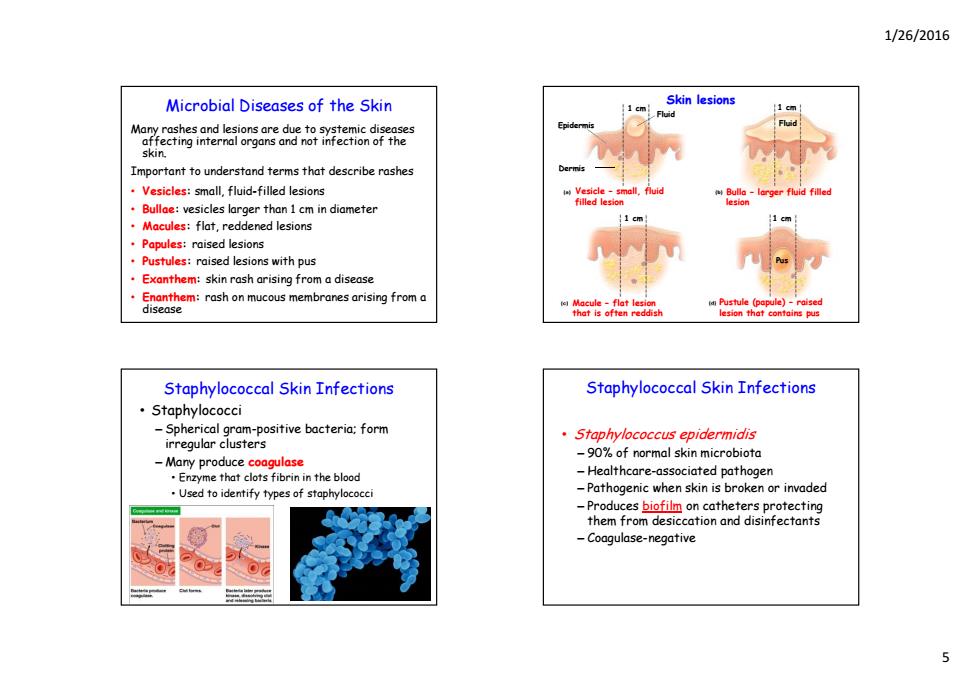
1/26/2016 Microbial Diseases of the Skin Skin lesions 1 cm 【1cm Fluid Epidermis Important to understand terms that describe rashes Dermis Vesicles:small,fluid-filled lesions Vesicle-small,fluid Bulla-larger fluid filled Bullae:vesicles larger than 1 cm in diameter filled lesion Macules:flat,reddened lesions Papules:raised lesions Pustules:raised lesions with pus Exanthem:skin rash arising from a disease Enanthem:rash on mucous membranes arising from a i Pustule disease contains pus Staphylococcal Skin Infections Staphylococcal Skin Infections Staphylococci -Spherical gram-positive bacteria:form irregular clusters Staphylococcus epidermidis -90%of normal skin microbiota -Many produce coagulase Enzyme that clots fibrin in the blood -Healthcare-associated pathogen Used to identify types of staphylococci -Pathogenic when skin is broken or invaded -Produces biofilm on catheters protecting them from desiccation and disinfectants -Coagulase-negative
1/26/2016 5 Microbial Diseases of the Skin Many rashes and lesions are due to systemic diseases affecting internal organs and not infection of the skin. Important to understand terms that describe rashes • Vesicles: small, fluid-filled lesions • Bullae: vesicles larger than 1 cm in diameter • Macules: flat, reddened lesions • Papules: raised lesions • Pustules: raised lesions with pus • Exanthem: skin rash arising from a disease • Enanthem: rash on mucous membranes arising from a disease Epidermis 1 cm Fluid D i 1 cm Fluid Skin lesions Dermis Vesicle – small, fluid filled lesion Bulla – larger fluid filled lesion 1 cm 1 cm Pus Macule – flat lesion that is often reddish Pustule (papule) – raised lesion that contains pus Staphylococcal Skin Infections • Staphylococci – Spherical gram-positive bacteria; form irregular clusters – Many produce coagulase • Enzyme that clots fibrin in the blood • Used to identify types of staphylococci Staphylococcal Skin Infections • Staphylococcus epidermidis – 90% f l k b % of normal skin microbiota – Healthcare-associated pathogen – Pathogenic when skin is broken or invaded – Produces biofilm on catheters protecting them from desiccation and disinfectants – Coagulase-negative

1/26/2016 Coagulase-negative staphylococci Staphylococcal Skin Infections urface of catheter Staphylococcus aureus -Can survive for months on surfaces -Larger genome than 5.epidermidis (300,000 bp) Coagulase-positive -May produce damaging toxins and cause sepsis Avoids host defenses in the skin 四 6) 四m Secretes proteins and toxins that ll phagocytic cells MRSA strains are antibiotic-resistant ·methicillin-resistant三.cres is beginning to appear. the biofilm. Staphylococcal Skin Infections Often transported from nasal passages to the skin where it can enter through openings such as the hair follicles Folliculitis:infections of the hair follicles Sty:folliculitis of an eyelash Furuncle (boil):a type of abscess;localized region of pus surrounded by inflamed tissue antibiotics do not penetrate well making it difficult to treat Carbuncle:damage and inflammation of deep ading furuncle group of Impetigo:crusting (nonbullous)sores, spread by autoinoculation 6
1/26/2016 6 Coagulase-negative staphylococci Biofilm Surface of catheter Biofilm Catheter surface with adhering bacteria. Biofilm, light green, is beginning to appear. Most of the bacteria producing the slime are not visible under the biofilm. Staphylococcal Skin Infections • Staphylococcus aureus – Carried in the nasal passages of 20% of the population py y y ermanently; 60% carry it transiently – Can survive for months on surfaces – Golden-yellow colonies; pigment protects against sunlight and killing by neutrophils – Larger genome than S. epidermidis (300,000 bp) – Coagulase-positive – M d d i i d i May produce damaging toxins and cause sepsis – Avoids host defenses in the skin • Secretes proteins and toxins that kill phagocytic cells – MRSA strains are antibiotic-resistant • methicillin-resistant S. aureus Staphylococcal Skin Infections Often transported from nasal passages to the skin where it can enter through openings such as the hair follicles • Folliculitis: infections of the hair follicles • Sty: folliculitis of an eyelash • Furuncle (boil): a type of abscess; localized region of pus surrounded by inflamed tissue - antibiotics do not penetrate well making it diffi lt t t t difficult to treat • Carbuncle: damage and inflammation of deep tissue from a spreading furuncle, group of hair follicles are infected • Impetigo: crusting (nonbullous) sores, spread by autoinoculation
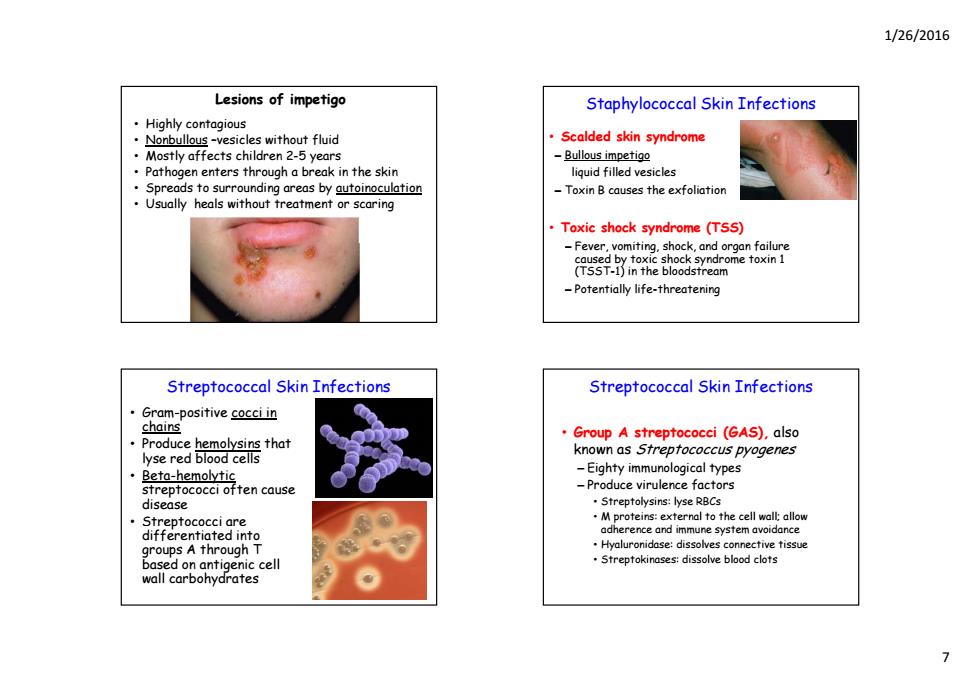
1/26/2016 Lesions of impetigo Staphylococcal Skin Infections Highly contagious Nonbullous -vesicles without fluid Scalded skin syndrome Mostly affects children 2-5 years -Bullous impetigo Pathogen enters through a break in the skin liguid filled vesicles Spreads to surrounding areas by autoinoculation Toxin B causes the exfoliation Usually heals without treatment or scaring Toxic shock syndrome (TSS) -Fever,vomiting,shock,and organ failure caused by toxic shock syndrome toxin 1 (TSST-1)in the bloodstream -Potentially life-threatening Streptococcal Skin Infections Streptococcal Skin Infections Gram-positive cocci in chains Produce hemolysins that Group A streptococci (GAS).also lyse red blood cells known as Strepfococcus pyogenes ·Beto-hemolytic -Eighty immunological types streptococci often cause -Produce virulence factors disease Streptolysins:lyse RBCs ·Streptococci are differentiated into groups A through T Hyaluronidase:dissolves connective tissue based on antigenic cell Streptokinases:dissolve blood clots wall carbohydrates
1/26/2016 7 Lesions of impetigo • Highly contagious • Nonbullous –vesicles without fluid • Mostly affects children 2-5 years • Pathogen enters through a break in the skin • Spreads to surrounding areas by autoinoculation • Usually heals without treatment or scaring Staphylococcal Skin Infections • Scalded skin syndrome – Bullous impetigo liquid filled vesicles – Toxin B causes the exfoliation • Toxic shock syndrome (TSS) – F iti h k d f il Fever, vomiting, shock, and organ failure caused by toxic shock syndrome toxin 1 (TSST-1) in the bloodstream – Potentially life-threatening Streptococcal Skin Infections • Gram-positive cocci in chains • Produce hemolysins that lyse red blood cells • Beta-hemolytic streptococci often cause disease • Streptococci are differentiated into groups A through T based on antigenic cell wall carbohydrates Streptococcal Skin Infections • Group A streptococci (GAS), also known as Streptococcus pyogenes – Eighty immunological types – Produce virulence factors • Streptolysins: lyse RBCs • M proteins: external to the cell wall; allow adh d i t id dherence and immune system avoidance • Hyaluronidase: dissolves connective tissue • Streptokinases: dissolve blood clots

1/26/2016 Streptococcal Skin Infections ·Erysipelas -5.pyogenes infects the dermal layer of the skin Starts as a rash:Causes local tissue destruction and sepsis Appears first on the face and is often preceded by Strepfococcal soar Throat Still sensitive to antibiotics Streptococcal Skin Infections Infections by Pseudomonads Necrotizing fasciitis -15,000 cases in the US each year with mortality rates Pseudomonas aeruginosa of40% -Gram-negative,aerobic rod:soil and water: -"Flesh-eating"disease grows on unusual organic matter uyo oribute -Pyocyanin produces a blue-green pus igen causing the -Associated with streptococcal toxic shock syndrome: -Pseudomonas dermatitis similar to staphylococcal TSS:higher mortality rate Self-limiting rash acquired in swimming pools Otitis externa "Swimmer's ear Resistant to many antibiotics
1/26/2016 8 M protein on fibrils Streptococcal Skin Infections • Erysipelas – S. pyogenes infects the dermal layer of the skin • St t h C l l ti d t ti d Starts as a rash; Causes local tissue destruction and sepsis • Appears first on the face and is often preceded by streptococcal soar throat • Still sensitive to antibiotics Streptococcal Skin Infections • Necrotizing fasciitis – 15,000 cases in the US each year with mortality rates of 40% – "Flesh-eating disease " disease – Extotoxin A produced by S. pyogenes acts as a superantigen causing the immune system to contribute to the damage – Associated with streptococcal toxic shock syndrome; similar to staphylococcal TSS; higher mortality rate Infections by Pseudomonads • Pseudomonas aeruginosa – Gram-negative, aerobic rod; soil and water; g g rows on unusual organic matter – Pyocyanin produces a blue-green pus – Produces exo- and endotoxins; grows in biofilms; health-care associated infections – Pseudomonas dermatitis • Self-limiting rash acquired in swimming pools – Otiti t Otitis externa • "Swimmer's ear" – Opportunistic in burn patients and cystic fibrosis patients (biofilm) – Resistant to many antibiotics
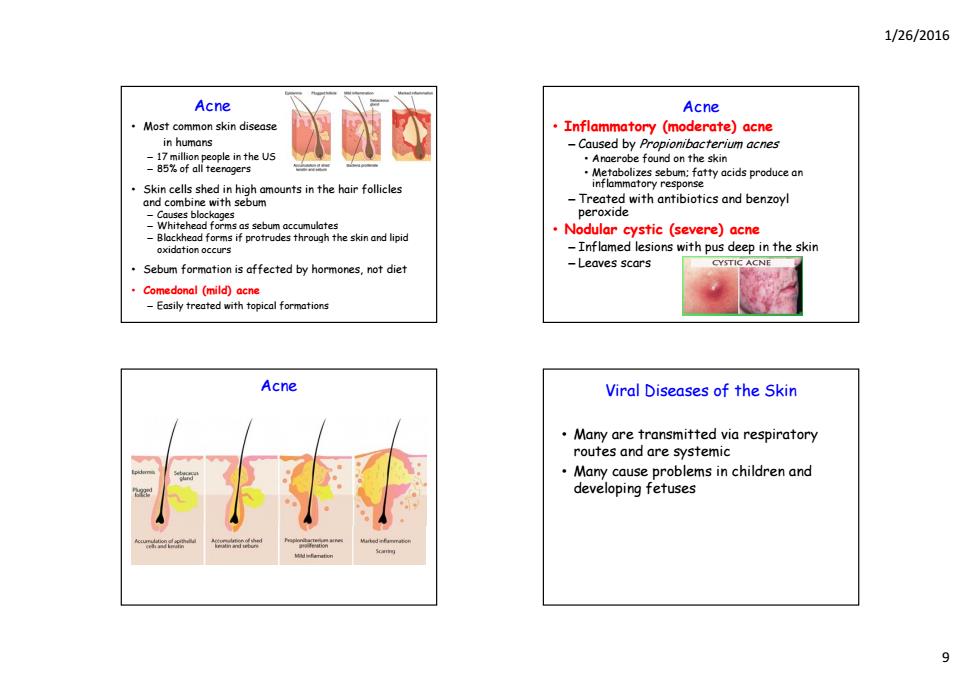
1/26/2016 Acne Acne Most common skin disease Inflammatory (moderate)acne in humans -Caused by Propionibacterium acnes -17 million people in the US Angerobe found on the skin -85%of alli teenagers Skin cells shed in high amounts in the hair follicles rtyaids padce n and combine with sebum -Treated with antibiotics and benzoyl peroxide -Blackhead forms if protrudes through the skin and lipid Nodular cystic (severe)acne oxidation occurs -Inflamed lesions with pus deep in the skin Sebum formation is affected by hormones,not diet -Leaves scars STIC ACNE Comedonal(mild)acne -Easily treated with topical formations Acne Viral Diseases of the Skin Many are transmitted via respiratory routes and are systemic Many cause problems in children and developing fetuses
1/26/2016 9 Acne • Most common skin disease in humans – 17 million people in the US – 85% f ll 85% of all teenagers • Skin cells shed in high amounts in the hair follicles and combine with sebum – Causes blockages – Whitehead forms as sebum accumulates – Blackhead forms if protrudes through the skin and lipid oxidation occurs • Sebum formation is affected by hormones, not diet • Comedonal (mild) acne – Easily treated with topical formations Acne • Inflammatory (moderate) acne – Caused by Propionibacterium acnes • Anaerobe found on the skin • Metabolizes sebum; fatty acids produce an inflammatory response – Treated with antibiotics and benzoyl peroxide • Nodular cystic (severe) acne – I fl d l i ith d i th ki Inflamed lesions with pus deep in the skin – Leaves scars Acne Viral Diseases of the Skin • Many are transmitted via respiratory rout d t i tes and are systemic • Many cause problems in children and developing fetuses
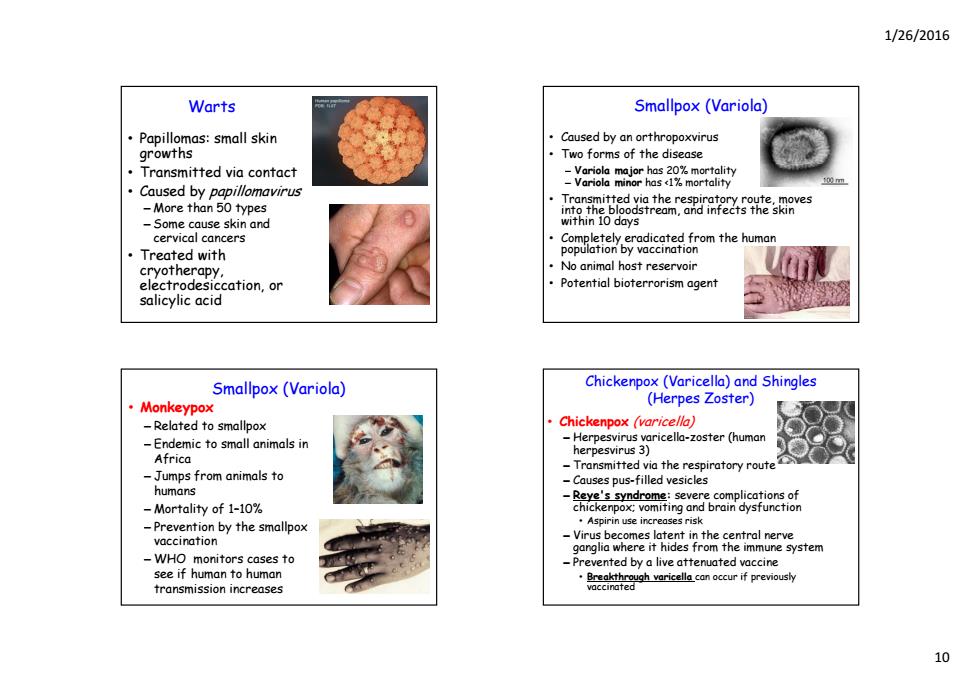
1/26/2016 Warts Smallpox(Variola) Papillomas:small skin Caused by an orthropoxvirus growths Two forms of the disease Transmitted via contact Caused by papillomavirus More than 50 types -Some cause skin and within 10 days cervical cancers Treated with om the humen cryotherapy. No animal host reservoir electrodesiccation,or Potential bioterrorism agent salicylic acid Smallpox (Variola) Chickenpox (Varicella)and Shingles ·Monkeypox (Herpes Zoster) -Related to smallpox Chickenpox (varicella) -Endemic to small animals in -Herpesvirus varicella-zoster (human herpesvirus 3) 9 Africa -Transmitted via the respiratory route -Jumps from animals to -Causes pus-filled vesicles humans -Reye's syndrome:severe complications of Mortality of 1-10% chickenpox:vomiting and brain dysfunction -Prevention by the smallpox Aspirin use increases risk vaccination -Virus becomes latent in the grga hereeo e mmune ystm -WHO monitors cases to -Prevented by a live attenuated vaccine see if human to human transmission increases 10
1/26/2016 10 Warts • Papillomas: small skin growths • Transmitted via contact • Caused by papillomavirus – More than 50 types – Some cause skin and cervical cancers • Treated with cryotherapy, electrodesiccation, or salicylic acid Smallpox (Variola) • Caused by an orthropoxvirus • Two forms of the disease – Variola major has 20% mortality – Variola minor has <1% mortality • Transmitted via the respiratory route, moves into the bloodstream, and infects the skin within 10 days • Comp y letel y eradicated from the human population by vaccination • No animal host reservoir • Potential bioterrorism agent Smallpox (Variola) • Monkeypox – Related to smallpox – Endemic to small animals in Africa – Jumps from animals to humans – Mortality of 1–10% – Prevention by the smallpox vaccination – WHO monitors cases to see if human to human transmission increases Chickenpox (Varicella) and Shingles (Herpes Zoster) • Chickenpox (varicella) – Herpesvirus varicella-zoster (human h p s i s 3) herpesvirus 3) – Transmitted via the respiratory route – Causes pus-filled vesicles – Reye's syndrome: severe complications of chickenpox; vomiting and brain dysfunction • Aspirin use increases risk – Virus becomes latent in the central nerve ganglia where it hides from the immune system – Prevented by a live attenuated vaccine • Breakthrough varicella can occur if previously vaccinated